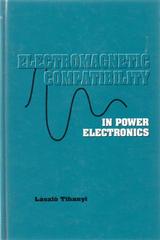
EMC in Power Electronics
L. Tihanyi
(1997) 416 pages
Electronics professionals will find this book invaluable when designing power equipment, because it describes in detail how to cope with the problem of electromagnetic interference. The author shows how to meet the exacting US and European EMC standards for conducted emissions. The book includes a wide range of EMI analysis techniques. An important focus is on the energy content of interference transient signals (traditional analysis concentrates on amplitude and frequency). This provides a more accurate picture of the EMI situation. For those who do not want or need detailed analysis techniques, many approximation methods are also provided. These simplified techniques give accurate results for all but the most stringent applications. The book contains several worked examples and an extensive bibliography, and is sure to be useful to electronic design engineers and others who need to meet international EMC regulations and standards. Laszlo Tihanyi has worked on EMC for over 20 years. Formerly Head of the Department of Power Electronics at the Hungarian Research Institute for the Electrical Industry, he focused primarily on solving EMI problems in electronic systems and developing a dimensioning method for power line filters.
Foreword; Preface; Chapter 1: Introduction; Chapter 2: History of EMC Standardization Efforts; Chapter 3: Description of Electromagnetic Disturbances@ 3.1 Classifying Disturbances by Frequency Content:3.2 Classifying Disturbances by Character:3.3 Classifying Disturbances by Transmission Mode:Chapter 4: Conducted EMI Measurement@ 4.1 EMI Measuring Instruments:4.2 Basic Terms and Conducted EMI References:4.3 Measuring the Interference Voltage:4.4 Measuring the Interference Current:4.5 Spectrum Analyzers:4.6 EMI Measurements for Consumer Appliances:4.7 Measuring Impulse-Like EMI:Chapter 5: EMI in Power Electronic Equipment@ 5.1 EMI from Power Semiconductors:5.2 EMI from Controlled Rectifier Circuits:5.3 EMI Calculation for Semiconductor Equipments:Chapter 6: EMI Filter Elements@ 6.1 Measuring HF Characteristics of EMI Filter Elements:6.2 Capacitors:6.3 Choke Coils:6.4 Resistors:Chapter 7: Noise Suppression@ 7.1 Noise Suppression in Relay Systems:7.2 Application of AC Switching Relays:7.3 Application of RC-Snubbers to Power Semiconductors:7.4 Shielded Transformers:7.5 Capacitor Filters:7.6 EMI Generation and Reduction at Its Source:7.7 Influence of Layout and Control of Parasitics:Chapter 8: EMI Filter Circuit Selection and Measurement@ 8. 1 Definition of EMI Filter Parameters:8.2 EMI Filter Circuits:8.3 Insertion Loss Test Methods:Chapter 9: EMI Filter Design@ 9.1 EMI Filter Design for Insertion Loss:9.2 Calculation of Worst-Case Insertion Loss:9.3 Design Method for Mismatched Impedance Condition:9.4 Design Method for EMI Filters with Common-Mode Choke Coils:9.5 Damped EMI Filters and Lossy Filter Elements:9.6 HF Characteristics of Noise Filter Circuit Elements:9.7 EMI Filter Layout:Chapter 10: Testing for Susceptibility to Power Line Disturbances@ 10.1 Surge Voltages in AC Power Mains:10.2 EMC Tests per IEC Specifications:10.3 Other EMS Test Methods:Chapter 11: Reduction Techniques for Internal EMI@ 11.1 Conductive Noise Coupling:l 1.2 Electromagnetic Coupling:11.3 Electromagnetic Coupling Reduction Methods:11.4 Wiring Layout Methods to Reduce EMI Coupling:11.5 PCB Design Considerations:Chapter 12: Transient Susceptibility Analysis Method@ 12.1 Noise Filter Design Method for Voltage Attenuation:12.2 Calculating the Energy Content of Transient Disturbances:12.3 Impulse Characteristics and Noise Filter Design:12.4 Surge Protection Devices:Bibliography@ Index
Contact us at info@electrostatic.com
https://www.electrostatic.com/ (jmc 2023-11-02) © 2023
 Electrostatic Applications
Electrostatic Applications